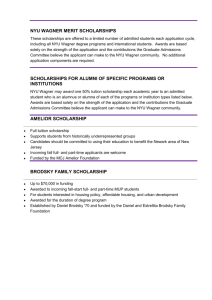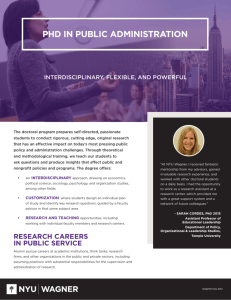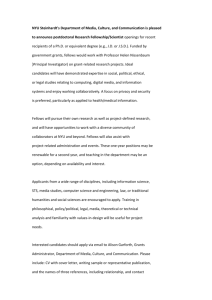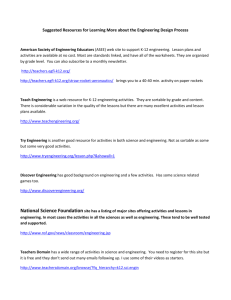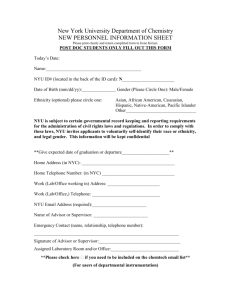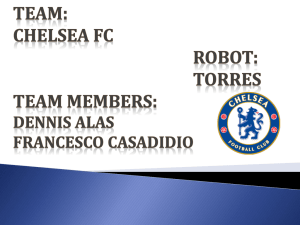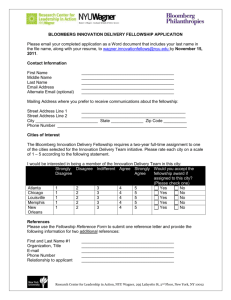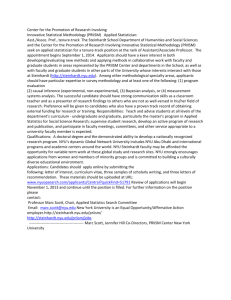NYU.1287_style guide_5.13
advertisement
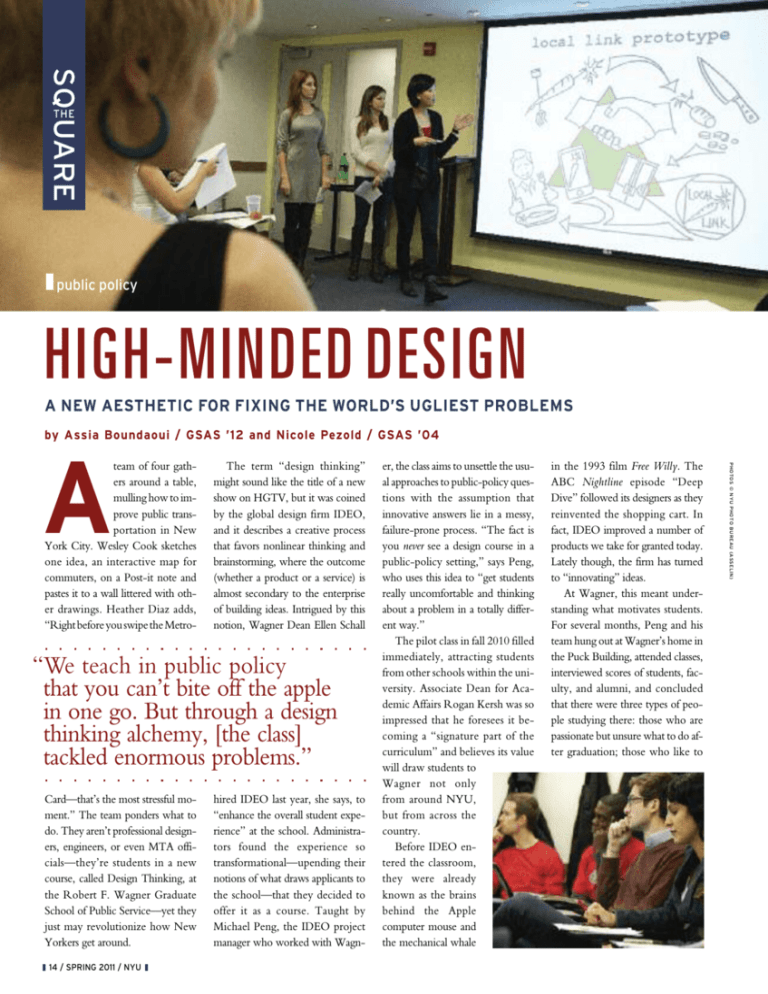
SQ UARE THE public policy HIGH-MINDED DESIGN A NEW AESTHETIC FOR FIXING THE WORLD’S UGLIEST PROBLEMS by Assia Boundaoui / GSAS ’12 and Nicole Pezold / GSAS ’04 The term “design thinking” might sound like the title of a new show on HGTV, but it was coined by the global design firm IDEO, and it describes a creative process that favors nonlinear thinking and brainstorming, where the outcome (whether a product or a service) is almost secondary to the enterprise of building ideas. Intrigued by this notion, Wagner Dean Ellen Schall “We teach in public policy that you can’t bite off the apple in one go. But through a design thinking alchemy, [the class] tackled enormous problems.” Card—that’s the most stressful moment.” The team ponders what to do. They aren’t professional designers, engineers, or even MTA officials—they’re students in a new course, called Design Thinking, at the Robert F. Wagner Graduate School of Public Service—yet they just may revolutionize how New Yorkers get around. 14 / SPRING 2011 / NYU hired IDEO last year, she says, to “enhance the overall student experience” at the school. Administrators found the experience so transformational—upending their notions of what draws applicants to the school—that they decided to offer it as a course. Taught by Michael Peng, the IDEO project manager who worked with Wagn- er, the class aims to unsettle the usual approaches to public-policy questions with the assumption that innovative answers lie in a messy, failure-prone process. “The fact is you never see a design course in a public-policy setting,” says Peng, who uses this idea to “get students really uncomfortable and thinking about a problem in a totally different way.” The pilot class in fall 2010 filled immediately, attracting students from other schools within the university. Associate Dean for Academic Affairs Rogan Kersh was so impressed that he foresees it becoming a “signature part of the curriculum” and believes its value will draw students to Wagner not only from around NYU, but from across the country. Before IDEO entered the classroom, they were already known as the brains behind the Apple computer mouse and the mechanical whale in the 1993 film Free Willy. The ABC Nightline episode “Deep Dive” followed its designers as they reinvented the shopping cart. In fact, IDEO improved a number of products we take for granted today. Lately though, the firm has turned to “innovating” ideas. At Wagner, this meant understanding what motivates students. For several months, Peng and his team hung out at Wagner’s home in the Puck Building, attended classes, interviewed scores of students, faculty, and alumni, and concluded that there were three types of people studying there: those who are passionate but unsure what to do after graduation; those who like to PHOTOS © NYU PHOTO BUREAU (ASSELIN) A team of four gathers around a table, mulling how to improve public transportation in New York City. Wesley Cook sketches one idea, an interactive map for commuters, on a Post-it note and pastes it to a wall littered with other drawings. Heather Diaz adds, “Right before you swipe the Metro- AT LEFT AND BELOW: STUDENTS PRESENT THEIR RESEARCH AND SOLU- campus life TIONS TO IDEO DESIGNERS. Fortunate Sons and Daughters THE POST-9/11 GI BILL SENDS A NEW GENERATION TO SCHOOL by Assia Boundaoui / GSAS ’12 and Nicole Pezold / GSAS ’04 I n 2003, as most of Kevin Torres’s friends were taking their seats in air-conditioned college classrooms, he was dressed in U.S. Army fatigues, baking in the Mesopotamian sun 6,000 miles away. Torres, a Brooklyn native, enlisted right out of high school and was among the first soldiers deployed to Iraq as the American invasion began. While friends back home fretted over upcoming exams, he faced challenges with potential life-or-death consequences, from his immediate security objectives to more nuanced worries about striking the right tone with the Iraqi civilians filing past his checkpoint. To treat them disrespectfully, he reasoned, might inspire support for future attacks against Americans, but he also had to be vigilant in his work. Four years and two tours later, Torres (STEINHARDT ’11) rejoined his old friends in the classroom—just as most of them were finishing bachelor’s degrees. Now a social studies undergraduate at the Steinhardt School of Culture, Education, and Human Development, Torres is one of thousands of veterans returning from battlefields to enroll in college through the Post-9/11 GI Bill. The program took effect in 2009, just as Torres started his first semester at NYU, and it has significantly increased the educational support— providing tuition, plus a monthly living stipend and yearly books allowance—available to a new generation of vets. Since August 2009, the Veterans Administration has paid more than $8 billion in benefits to over 440,000 students. While this pales in comparison to the original GI Bill—which sent nearly half of the 16 million World War II veterans to a college or training program—the numbers continue to rise. The bill covers veterans who’ve served on or since September 11, 2001, and vastly reduces the financial obstacle to an education. But many vets still face social hurdles on campus. Fitting in with other students can be a challenge—they’re often younger and, Torres believes, sometimes make assumptions about vets being depressed, violent, or spokespeople for unpopular U.S. foreign KEVIN TORRES SERVED TWO TOURS IN IRAQ. policies. In his first semester, he told no one about his He was in the army. He loves combat duty. “I didn’t want to be killing people.’ ” the kid who wears it on his sleeve,” One thing Torres is unburhe says. “The veteran who every dened by, however, is debt. Betime there’s a mention of the [Iraq] tween the GI Bill and additional war or war in general, it’s like, scholarship aid from Steinhardt, ‘Oh, yeah, Kevin can speak to he will finish his degree in May that.’ I can’t speak to the Ameri- able to channel all his energy into can Revolution—it was 1776!” graduate school. He’s applying to This reaction is common master’s programs in education among enrolling vets, notes Jodi and hopes that his own experiBailey, former associate director of ence in Iraq will give future stuNYU’s Student Resource Center. dents a rare and intimate view of “Coming back into the everyday- recent history. NYU / SPRING 2011 / 15 PHOTO © MATTHEW SEPTIMUS deeply explore one field at a time; and those who’re certain where they want to end up. “IDEO’s framework enabled us to craft and design additional support mechanisms for our student body,” Kersh recalls. Understanding the diversity of their mind-set, the school is now investing in more sophisticated ways of welcoming new students and is developing informal study areas and an academic networking site. To teach design thinking, Peng split the class into teams and charged each with a mammoth question. To answer it, they had to create a lean and tangible solution using design methods, such as interviewfocused research, prototyping, and experimentation. He gave one team the task of providing sustainable living in the city and another of improving the U.S. health-care system. All would present their ideas at the end of the semester. When presentation day came, Peng gathered several IDEO designers, as well as Kersh and other Wagner faculty, to critique each group’s idea. Wesley Cook, Heather Diaz, and the transportation team screened a video to walk viewers through the daily frustrations of a New York City subway commuter. They zeroed in on the system’s shortcomings and then presented a string of solutions, including a smartphone app that alerts riders of service changes, a digital panel outside subway stops to inform people—before they descend into the station—when the next train is arriving, and signage to channel and diffuse the human traffic jams at rush hour. “We teach in public policy that you can’t bite off the apple in one go,” Kersh says. “But [the class] tackled enormous problems, reduced them to an important essence, and devised process-based solutions that made sense. I can’t imagine a more valuable blending of theory and practice.” ness of things can be disconcerting when the people around you cannot relate to what you have just experienced,” she says. The center offers assistance in navigating the civilian world—addressing admissions questions, resolving issues with housing or classes, and connecting them to VA services in the city. It also regularly hosts speakers and is one of several ways that the estimated 270 former soldiers enrolled at NYU can meet others who share the experience of war. Another is the Military Veterans Club at the Leonard N. Stern School of Business and NYU’s Military Alliance, an affinity group for students and alumni. Torres, an active member of the Military Alliance, has only recently become more comfortable identifying himself as a vet to classmates, but even so he wonders whether “that will change their perception [of me], like, ‘Look at that guy.
